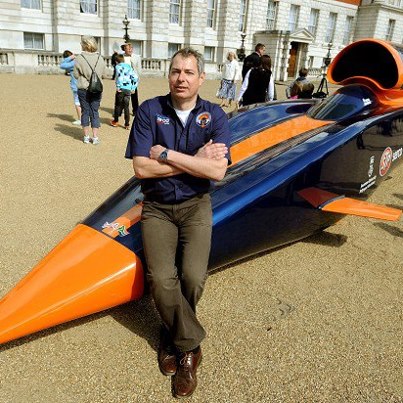First test of British rocket car that ‘could hit 1,000mph’
The rocket will be twinned with a fighter jet engine from a Eurofighter Typhoon on the Bloodhound supersonic car in a bid to smash the existing world land speed record of 763 mph set 15 years ago by the same team in Thrust SSC.
The test-firing, which produced a jet of flame from the rocket fixed to a test rig in a bomb-proof military hangar at an airport in the southwest English town of Newquay, lasted a matter of seconds.
"That's exactly what I was hoping to see," said Andy Green, the Royal Air Force fighter pilot who will sit in the driving seat for the record bid. "That was a hugely successful, very, very important experiment for us."
The test brought together three components; the rocket itself, a tank containing the peroxide-based rocket fuel and a Cosworth Formula One engine used purely to pump the fuel into the combustion chamber.
Test data showed the rocket produced 14,200 pounds of thrust with the Cosworth engine running at over 16,000 revolutions per minute. Further tests through the end of this year and into 2013 will ramp up the power.
For the record bid, the rocket is designed to generate 27,500 pounds of thrust, equivalent to 80,000 horsepower or the combined output of 95 Formula One cars.
The team say they have enough funding from sponsors to complete the car, which so far only exists on paper.
Bloodhound will attack 1,000 mph on a dry lake bed called Hakskeen Pan in South Africa's Northern Cape region in 2014. Reuters
 |
| Mark Chapman |
09/29/12 Engineers planning to test what they describe as Europe's largest hybrid rocket car next week say they are confident it will work – so confident the exercise is being streamed live on the internet.
The Bloodhound Supersonic Car, developed by the education initiative the Bloodhound Project, will be put through its paces at Newquay Cornwall Airport on October 3. The Bloodhound is described as the largest rocket car of its kind to be designed in Europe and the biggest rocket test in the UK in 20 years.
Chief engineer Mark Chapman said any result from the first full testing of the car would be worthwhile.
"Pretty much anything we get out of Newquay next week will be a success," he said. "It is unusual that (members of the public) are seeing a rocket very early in development. When you see this thing work or fail it will be the first time we see it work or fail. We're very confident this will work. The worst thing that could happen is nothing could happen but that also lets us know what else has failed."
Mr. Chapman said the car, which is powered by a jet engine and a rocket, could partly explode but that was all part of the development test. It will attempt a record breaking speed of 1,000 mph by 2014.
The pencil-shaped car is 12ft (4m) long, 18ins (45.7cm) in diameter and weighs 992lb (450kg). In its ultimate form, it is expected to generate the combined output of 95 Formula 1 cars.
Rocket engineer Dan Jubb said showcasing the first test was all about educating young people about science and technology, which is a key aim of the Bloodhound Project.
"The key point is that this is not us developing a rocket and then inviting everyone to come and see the final sign off where success is basically assured," said Mr. Jubb.
"This is about Bloodhound sharing the engineering scientific challenges and letting everybody see the development as it happens. I don't think there's been this level of access to a rocket at this level of maturity since probably Apollo."
